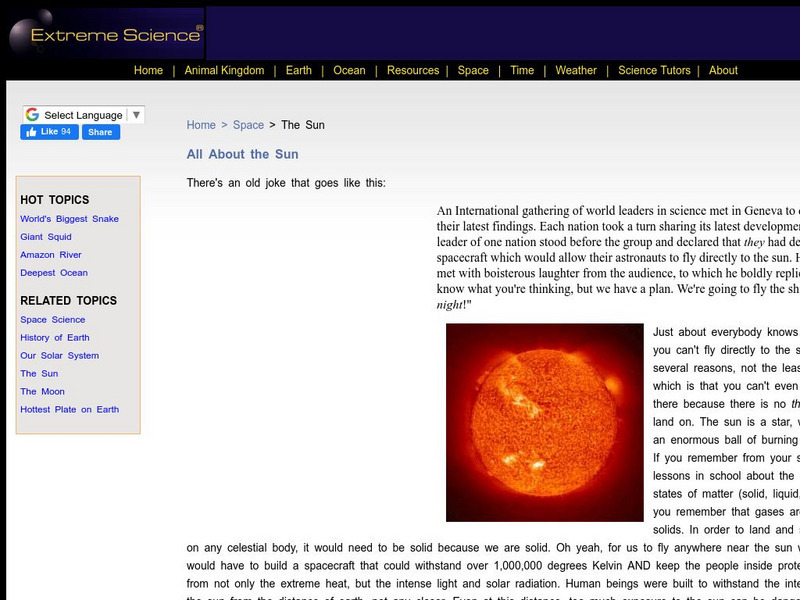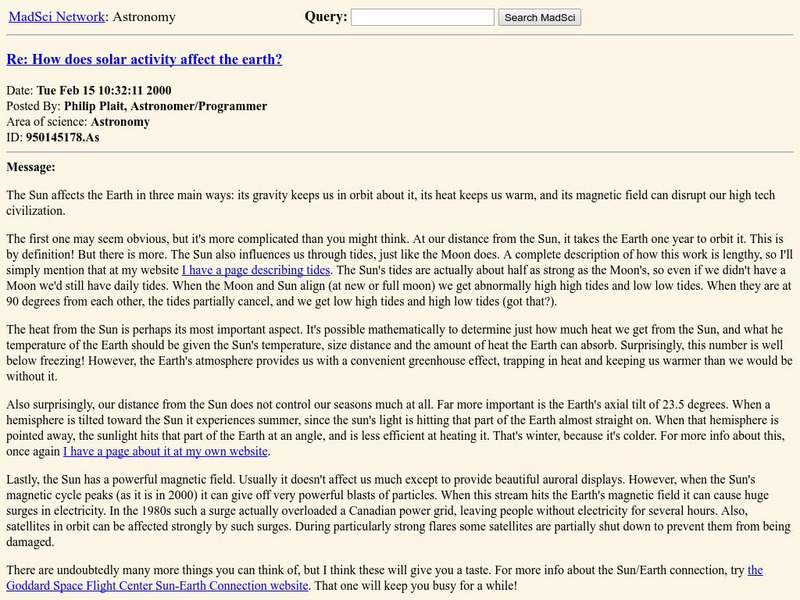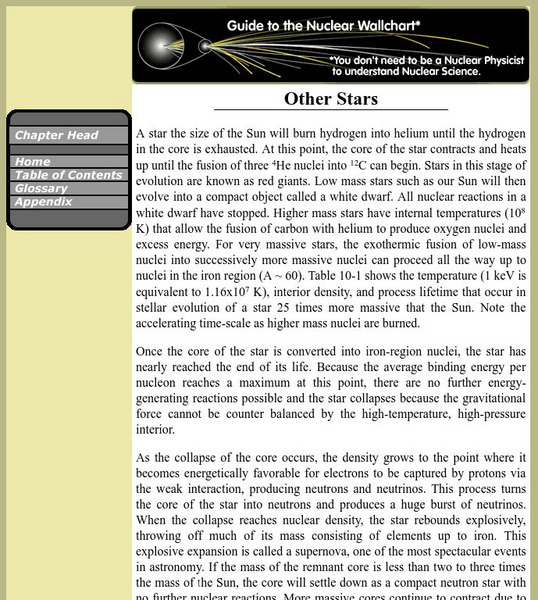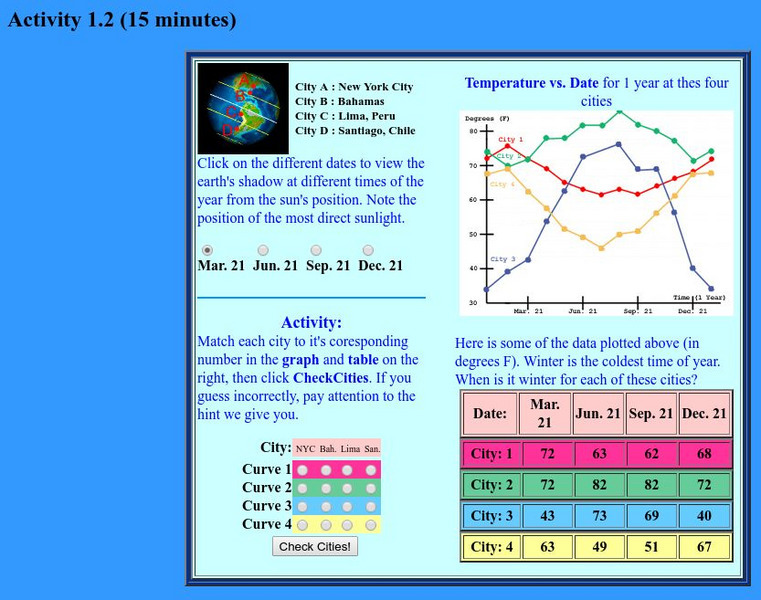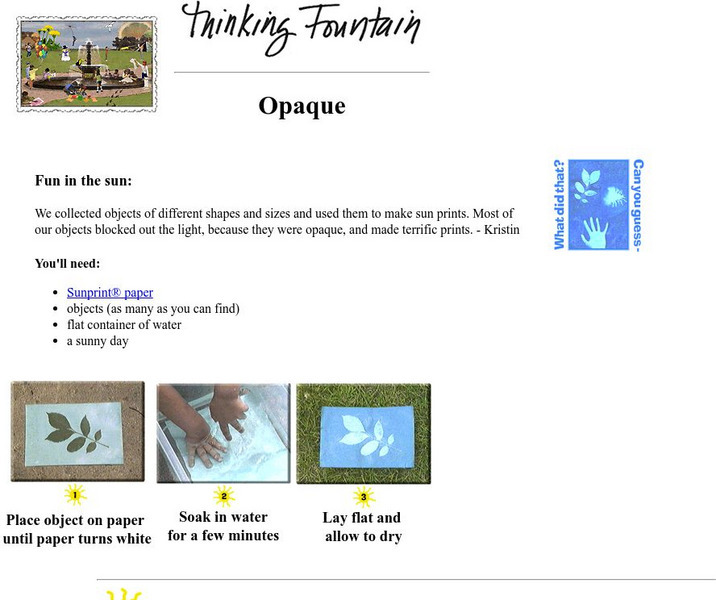University Corporation for Atmospheric Research
Ucar: Coronal Mass Ejection (Cme)
A Coronal Mass Ejection (CME) is a powerful, explosive "storm" from the Sun. CMEs hurl millions of tons of particle radiation outward into space.
Khan Academy
Khan Academy: Practice: Anatomy of the Sun Quiz
It might look like a solid object, but the Sun is very different from Earth. Find out what it's made of, and how reactions inside the Sun generate all that energy and drive powerful solar storms. Try this quiz!
Science Buddies
Science Buddies: Kinesthetic Astronomy: Earth's Rotation
This kinesthetic activity will demonstrate concepts like rotation and orbit, clarify movement and direction, and help students understand why earthlings see different things in the sky.
University of Texas at Austin
The University of Texas Mc Donald Observatory: Sunspots
Experiment involves identifying sunspots, temporary phenomena on the Sun's photosphere that appear as spots darker than the surrounding areas.
University of Texas at Austin
The University of Texas Mc Donald Observatory: Shadow Play
Everyone and everything has a shadow. Shadows illustrate how three-dimensional objects can be viewed in two dimensions.
Science Buddies
Science Buddies: How Big Are the Planets in Our Solar System?
This activity explores the relative size of the eight planets that circle around the Sun.
NASA
Nasa Space Place: What Are the Moon's Phases?
Describes the eight moon phases and why they happen.
University Corporation for Atmospheric Research
Ucar: Why Does Climate Change?
Factors that have the power to change global climate can be natural, like volcanic eruptions and changes in solar energy, or caused by humans, like the addition of greenhouse gases to the atmosphere.
University Corporation for Atmospheric Research
Ucar: The Sun
Learn about the sun, the center of our solar system and the closest star to Earth.
Extreme Science
Extreme Science: All About the Sun
Read about the sun, the source of its energy, solar activity, sunrise/sunset times, solar flares, and other interesting facts.
Cornell University
Cornell University: Astronomy: Eclipses
This site from the Astronomy Department of Cornell University provides brief introduction to both solar and lunar eclipses. Links are provided for pictures and charts of the eclipses, and this is a good site to check out on the subject.
MadSci Network
Mad Scientist: Why High Tide Away From the Moon or Sun?
An excellent and thorough answer to the often asked question about high tide "bulges" on the side of Earth facing away from the Moon or Sun.
Australian Broadcasting Corporation
Australian Broadcasting Corporation: News in Science: Secrets of the Sun's Sizzling Corona
From ABC News in Science, Larry O'Hanlon's article on the sun's corona covers information related to the inner workings of the sun. Several included topics are "Sound makes heat" and "Reaching the surface."
Australian Broadcasting Corporation
Australian Broadcasting Corporation: News in Science: Sun's Magnetic Field
From ABC News in Science, this article, "Sun's magnetic field twisted and tangled," discusses images taken of "plumes of gas" which are rising from the sun's corona.
Cosmos 4 kids
Cosmos4 Kids: Solar System: Sun
Learn the basic facts about the sun. Brief, to the point text make this site most appropriate for younger students.
Other
Escolar.com: La Luz
A brief summary and illustrations of light and how the lights rays are reflected and bent.
Lawrence Berkeley National Laboratory
Berkeley Lab: The Sun
This page provides a brief discussion of the sun and its energy flow.
Lawrence Berkeley National Laboratory
Berkeley Lab: Other Stars
Describes other stars besides the sun in our galaxy and the major stages in the evolution of a massive star.
PBS
Pbs Learning Media: Earth's Albedo and Global Warming
In this interactive activity adapted from NASA and the U.S. Geological Survey, learn about Earth's albedo (the ratio of reflected vs. incident solar radiation), how pollution alters albedo, and how ice-albedo feedback may accelerate...
University of Utah
University of Utah: Aspire: Seasons Exercise
In this activity, use seasons to determine your location. Click on the different dates to view the earth's shadow at different times of the year from the sun's position.
US Navy
Astronomical Applications Department: Complete Sun and Moon Data for One Day
You can obtain the times of sunrise, sunset, moonrise, moonset, transits of the Sun and Moon, and the beginning and end of civil twilight, along with information on the Moon's phase by specifying the date and location in one of the two...
Hunkins Experiments
Hunkin's Experiments: Potato Maze
Hunkin's Experiments is a group of simple cartoon illustrations of scientific principles. Some would work well in the classroom, but others have little value beyond entertaining students. All of the projects are easy to do. This one is a...
Science Museum of Minnesota
Science Museum of Minnesota: Thinking Fountain: Opaque
In this lesson use objects found around the house or classroom to make sun prints. Link provided for the construction of a light island for classroom use.
Kidport
Kidport Reference Library: Energy
A simple introduction to energy, offering information on hydro-electric energy, fossil fuels, nuclear power, solar energy, and wind energy.






